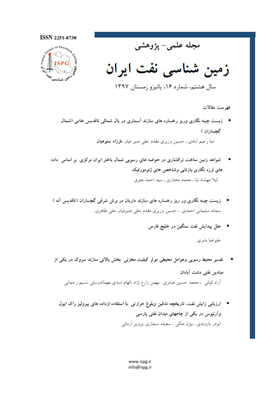شواهد زمین¬ساخت ترافشاری در حوضه¬های رسوبی شمال باختر ایران مرکزی بر اساس داده¬های لرزه¬نگاری بازتابی و شاخص¬های ژئومورفیک
محورهای موضوعی : شاخه های دیگر علوم زمین در ارتباط با زمین شناسی نفتمحمد مختاری 1 , سید احمد علوی 2 , لیلا مهشادنیا 3
1 - مرکز پیش بینی زلزله
2 - دانشگاه شهید بهشتی
3 - دانشگاه شهید بهشتی
کلید واژه: تکتونیک فعال وارونگی مثبت حوضه های کششی شمال باختر ایران مرکزی,
چکیده مقاله :
حوضه های فروافتاده آران-سراجه بین گسل های کوشک نصرت و سامانه ایندس - قم –خورآباد- کاشان (گسل قم-زفره) قرار گرفته است. وجود ضخامت بالای رسوبات، شناسایی ساختارهای درون حوضه ای را دشوار ساخته است. برای شناسایی عناصر ساختاری فعال و سازوکار تشکیل این حوضه ها از تلفیق شاخص های ژئومورفیک و تفسیر خطوط لرزه ای بازتابی استفاده شد. شواهد موجود در خطوط لرزه ای مراحل اصلی دگرریختی درون حوضه ای، نشانگر حضور میدان تنش کششی محلی است. ساختارهای این مرحله شامل چین های کششی-چرخشی و گسلش نرمال است که در نتیجه آن حوضه های رسوبی عمیق و نهشته شدن سازندهای سرخ زیرین و بالایی است. با ادامه دگرریختی، وارونگی مثبت و فشاری جایگزین شده است. در این مطالعه فعالیت برخی از گسل های نرمال و مرزی و چین های کششی به صورت فشاری تایید گردید. ساختارهای جوانتر این مرحله شامل پس راندگی ها، پیش راندگی ها، ساختارهای میانبر و ساختارهای بالاآمدگی است که همگی نشان دهنده معکوس شدگی زمین ساختی حوضه ها ی کششی اولیه است. بخش های فعال فشاری حوضه بر اساس شاخص های ژئومورفیک، شامل فرادیواره راندگی ساوه و خم فشاری واقع در پایانه جنوب خاوری گسل ایندس است. همچنین فشردگی حوضه ها و فعالیت گسل های راندگی رشدی کف حوضه ، سبب تشکیل ساختار های بالا رانشی در مرکز هر سه حوضه شده است. دگرریختی در این حوضه ها در حال حاضر به صورت ترافشاری است.
The depressed basins of northwest central Iran are located in the structural Step and between Soltanieh-Ipac-Koshk-e-Nosrat and Qom –Zefreh system (the Indes - Qom –Khurabad faults). The main process of deformation within the basin with extension and compression of specific structures are comparable and verifiable using experimental models. The extensional structures include roll-over folds and normal faults, resulting in deep sedimentary basins during deposition of the lower and upper red formations. The younger structures, includes back-thrusts and for-thrusts, shortcut, and pop up structures represents the reversal of tectonic of primary extensional basin. These sedimentary basins have been created in relation to the growth faults and hanging wall blocks So In the presence of roll-over fold and antithetic and synthetic faults therefore are suitable for entrapment of hydrocarbons during migration. The active structural features have been identified using combination of geomorphic characteristic and seismic reflection data. Accordingly, none of the old normal faults in the Saveh- Qom and Aran basin show at the present any extensional movement and the fault activity of boundary faults and extensional folding are compressional. The active parts are: hanging wall of Saveh, restraining bending at the end of Indes fault that has stream Length-Gradient (SL) index and high value hypsometric index (Hi). The central part of Saveh-Qom and Aran basin, although show high Hi but the SL is low. This situation is due to the moderating effects of the thick lower and upper red formations and evaporative layer within the basin. In the Aran basin due to incomplete coverage of seismic lines the absence of normal faults cannot be definitively confirmed. However, the center of Aran basin as of Qom-Saveh formed push up which marks the compression of this basin and also activity of reverse and thrust faults. Based on the existing surface and subsurface data set, active deformation in this area now is transpression basin and the interior domains are in the uplift.
